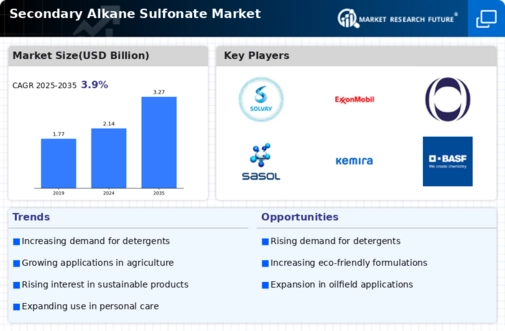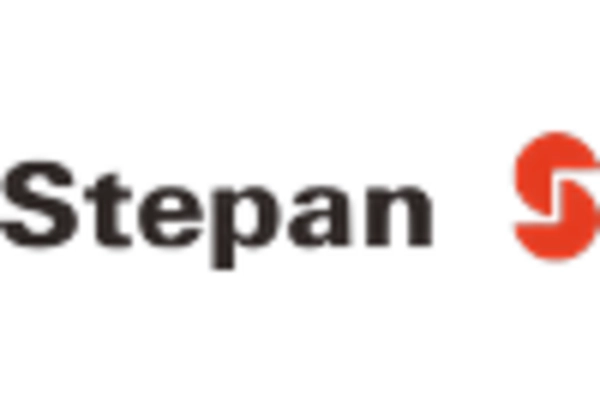The Secondary Alkane Sulfonate Market is currently characterized by a dynamic competitive landscape, driven by increasing demand across various applications, including detergents, personal care products, and industrial cleaners. Key players such as BASF SE (Germany), Stepan Company (US), and Huntsman Corporation (US) are strategically positioned to leverage their extensive product portfolios and innovative capabilities. BASF SE (Germany) focuses on sustainability and innovation, aiming to enhance its product offerings while reducing environmental impact. Stepan Company (US) emphasizes regional expansion and product diversification, which allows it to cater to a broader customer base. Huntsman Corporation (US) is actively pursuing digital transformation initiatives to optimize its operations and improve customer engagement, thereby enhancing its competitive edge. Collectively, these strategies contribute to a moderately fragmented market structure, where the influence of major players is significant yet allows for the emergence of niche competitors.
In terms of business tactics, companies are increasingly localizing manufacturing to reduce lead times and enhance supply chain efficiency. This approach not only mitigates risks associated with global supply chains but also aligns with the growing consumer preference for locally sourced products. The competitive structure of the Secondary Alkane Sulfonate Market appears to be moderately fragmented, with several key players exerting considerable influence. The collective actions of these companies shape market dynamics, fostering an environment where innovation and operational efficiency are paramount.
In August 2025, BASF SE (Germany) announced the launch of a new line of biodegradable secondary alkane sulfonates, aimed at meeting the rising consumer demand for sustainable products. This strategic move underscores BASF's commitment to sustainability and positions the company favorably in a market increasingly driven by eco-conscious consumers. The introduction of biodegradable options may not only enhance BASF's product portfolio but also strengthen its market share in the growing segment of environmentally friendly products.
In September 2025, Stepan Company (US) expanded its manufacturing capabilities in Brazil, a strategic decision aimed at tapping into the burgeoning South American market. This expansion is likely to enhance Stepan's operational efficiency and responsiveness to regional demand, thereby solidifying its competitive position. By localizing production, Stepan can better serve its customers while potentially reducing costs associated with importation and logistics.
In October 2025, Huntsman Corporation (US) unveiled a new digital platform designed to streamline customer interactions and improve service delivery. This initiative reflects Huntsman's focus on digital transformation, which is increasingly vital in today's market. By enhancing customer engagement through technology, Huntsman is likely to differentiate itself from competitors, fostering loyalty and potentially increasing market share.
As of October 2025, the competitive trends within the Secondary Alkane Sulfonate Market are increasingly defined by digitalization, sustainability, and the integration of advanced technologies. Strategic alliances among key players are shaping the landscape, facilitating knowledge sharing and resource optimization. Looking ahead, it appears that competitive differentiation will evolve from traditional price-based competition to a focus on innovation, technological advancements, and supply chain reliability. Companies that can effectively navigate these trends are likely to emerge as leaders in the market.

















Leave a Comment